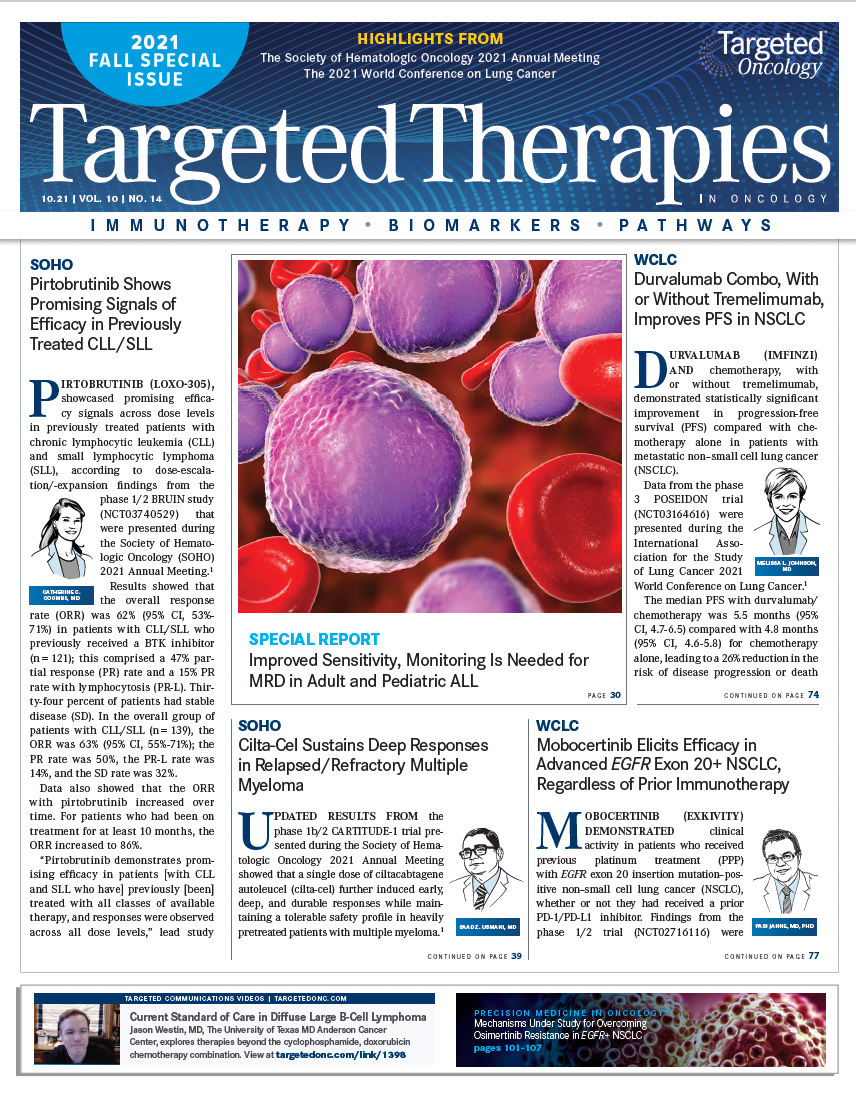Progress Is Being Made Toward Improvements in Biomarker Testing, Turnaround Times for NSCLC
In an interview with Targeted Therapies in Oncology, Nicholas J. Robert, MD, discussed what the results to date of the MYLUNG study mean for patients with non–small cell lung cancer.

The growing number of approved targeted therapy options for patients with molecularly driven non–small cell lung (NSCLC) is underscoring the need for biomarker testing in all patients to determine if they would be appropriate candidates for the use of these targeted agents. However, the frequency of testing, the number of genes tested for, and the amount of time for results to be returned do not always align with industry recommendations for the optimal management of patients with NSCLC.
The MYLUNG research study aimed to identify such trends in testing rates and times and how they could be improved.
In presentations during the International Association for the Study of Lung Cancer 2021 World Conference on Lung Cancer, investigators gave updates on the protocols of the MYLUNG study and the results to date.
During the meeting, Nicholas J. Robert, MD, vice president of Medical Affairs, Ontada, said that protocol 1 of the study looked at real-world data of biomarker testing in more than 3500 patients with metastatic NSCLC. He noted that although data showed that progress has been made toward increased biomarker testing, more progress is needed to improve care for all patients with NSCLC.
In an interview with Targeted Therapies in Oncology™ (TTO), Robert discussed what the results to date of the MYLUNG study mean for patients with NSCLC.
TTO: Please explain the rationale for the MYLUNG Consortium and the data presented at the World Lung meeting?
It’s important to identify molecular drivers for lung cancer, given the development of FDA-approved targeted therapies. It is key that biomarker testing occurs in this group of patients with metastatic non–small cell lung cancer. This study was done in conjunction with the MYLUNG Consortium, which is a collaboration of Th US Oncology Network, US Oncology Research, and Ontada, [with the] support of certain pharmaceutical partners and patient advocacy groups. MYLUNG stands for Molecularly Informed Lung Cancer Treatment in a Community Cancer Network. And the goal is to evaluate biomarker testing retrospectively. And the next step is to do a prospective protocol (protocol 2), which has been presented by Makenzi Evangelist, MD, at World Lung,2 and then move on to protocol 3, which is an intervention study to see how we can improve on biomarker testing.
So this is a retrospective review. It is over a 2-year period from April 2018 to March 2020. And we looked at markers that were recommended by the [National Comprehensive Cancer Network] in terms of what biomarkers should be used for metastatic non–small cell lung cancer. This includes EGFR, ALK, ROS1, BRAF, and NTRK. What we presented at World Lung is specifically looking at the assays. So as you can imagine, there are different methodologies for identifying biomarkers and they vary from biomarker to biomarker. We also looked at turnaround time—the time it takes from when you ordered tests to [when you] get the test back to take care of a patient.
What were the overall characteristics of the patients included in the study?
In terms of the patients themselves, we looked at 3474 patients. Median age was 69, [and] there was a slight predominance of women, 51.1% vs 48.9%. Most of the patients were White, although we had a population of Black/African Americans of 8% and “other” about 6%. Most patients had an ECOG status of 0 or 1. And the most common histology of non–small cell lung cancer was adenocarcinoma.
What have the results shown so far?
What we observed is that testing rates were highest for EGFR and ALK, around 70%, [and] lower for ROS1, BRAF, and NTRK, around 68%, 55%, and 17%, respectively. Rates were relatively stable over a 2-year period. But we did also notice that [the frequency of using] NGS [next-generation sequencing] had increased. And the advantage of NGS is hundreds of genes are often tested using this platform and have the opportunity of not only identifying genes of interest, but also potentially emerging gene markers.
In terms of the testing, as I described, that was pretty stable. But in terms of the methods, NGS for EGFR increased from 36% to 53%. Other methodologies, as you might expect, decreased. Those other methodologies included [polymerase chain reaction], Sanger, pyrosequencing, and snapshot testing. When you look at the other markers, you see similar trends with an increase in NGS overall. That’s true for ALK, ROS1, and BRAF. The only exception was NTRK, which was relatively stable.
What about for turnaround time?
The turnaround time was about 6 days from diagnosis to NGS order, and the time from the tests being ordered and the test result being obtained was 28 days. NGS testing from order to results took about 18 days.
The conclusions were that we are doing better in terms of testing—we’re seeing more NGS testing done. The turnaround time still varies. From diagnosed biomarker, as I said, about 4 weeks, and then 2.5 weeks from biomarker test to result. This still is considered too long and should be done sooner because, obviously, there are patients who need to be treated. And the sooner the data are available, the sooner they can be treated with an informed treatment plan.
What are some of the major takeaways from these results?
think that the good news is we’re doing more biomarker testing. But we need to continue to strive [to reach our goals]. What is the goal? Probably about 90%-plus of patients [should undergo biomarker testing]. There [are going to] be some patients that, because of their performance status, their comorbidities, [and] other factors that [indicate they are] not candidates for any real treatment, best supportive care. But most patients will be candidates. And, in general, targeted therapy is better tolerated than chemotherapy or chemoimmunotherapy. So, getting testing done is absolutely the goal here.
The good news is, we’re making progress. NGS appears to be the most effective platform because [there are now more and more genes that should be tested for] routinely in patients with metastatic NSCLC.
So I think the [main takeaway] message is test, test, test, and probably the best platform is NGS. In our network, we fortunately have an [electronic medical record] that really supports testing; there are reminders to our physicians to make sure they’re testing before they start treatment.
REFERENCES:
1. Robert NJ, Chen L, Espirito JL, et al; MYLUNG Consortium collaborators. Trends in molecular testing for metastatic non-small cell lung cancer in The US Oncology Network community practices. Poster presented at: 2021 World Conference on Lung Cancer; September 8-14, 2021; virtual. Abstract P60.11.
2. Evangelist MC, Jotte RM, Spira A, et al; MYLUNG Consortium collaborators. MYLUNG Consortium™: Molecularly Informed Lung Cancer Treatment in a Community Cancer Network. Pragmatic Prospective RWR Study. Poster presented at: 2021 World Conference on Lung Cancer; September 8-14, 2021; virtual. Abstract P60.13.

Survivorship Care Promotes Evidence-Based Approaches for Quality of Life and Beyond
March 21st 2025Frank J. Penedo, PhD, explains the challenges of survivorship care for patients with cancer and how he implements programs to support patients’ emotional, physical, and practical needs.
Read More